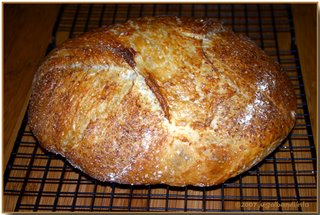
Not the 70s group, or the colloquialism for money, I am talking the real thing - gluten goodness. In case you missed it (I did) there was a earth shaking moment in the baking world about 2 years ago (Nov 8, 2006). The NY Times published a "no kneed" bread recipe from a guy named Jim Lahey. This thing was bigger than bread before it was sliced. I was alerted to this fact a couple of weekends ago when I read in the Sunday paper about an improvement to this recipe. I was intrigued, I looked up the original and I was flabbergasted at the number of hits you get when you google "no kneed bread" go ahead - try it.
Sooo, I had to bake it, and I did. It was the best I ever made. It was very simple, it just took time and a dutch oven with a lid (I used my Le Crueset). I highly recommend you give it a try.
Side note: I cracked the plastic handle on the top of my dutch oven in the oven and my wife went to get me a new one. The lady at the Le Crueset store knew just what had happened and pointed to a new mental handle and said "they started making those just because of that recipe" Bon Apatite
Adapted from Jim Lahey, Sullivan Street Bakery
Time: About 1½ hours plus 14 to 20 hours’ rising
3 cups all-purpose or bread flour, more for dusting
¼ teaspoon instant yeast
1¼ teaspoons salt
Cornmeal or wheat bran as needed.
In a large bowl combine flour, yeast and salt. Add 1 5/8 cups water, and stir until blended; dough will be shaggy and sticky. Cover bowl with plastic wrap. Let dough rest at least 12 hours, preferably about 18, at warm room temperature, about 70 degrees.
Dough is ready when its surface is dotted with bubbles. Lightly flour a work surface and place dough on it; sprinkle it with a little more flour and fold it over on itself once or twice. Cover loosely with plastic wrap and let rest about 15 minutes.
Using just enough flour to keep dough from sticking to work surface or to your fingers, gently and quickly shape dough into a ball. Generously coat a cotton towel (not terry cloth) with flour, wheat bran or cornmeal; put dough seam side down on towel and dust with more flour, bran or cornmeal. Cover with another cotton towel and let rise for about 2 hours. When it is ready, dough will be more than double in size and will not readily spring back when poked with a finger.
At least a half-hour before dough is ready, heat oven to 450 degrees. Put a 6- to 8-quart heavy covered pot (cast iron, enamel, Pyrex or ceramic) in oven as it heats. When dough is ready, carefully remove pot from oven. Slide your hand under towel and turn dough over into pot, seam side up; it may look like a mess, but that is O.K. Shake pan once or twice if dough is unevenly distributed; it will straighten out as it bakes. Cover with lid and bake 30 minutes, then remove lid and bake another 15 to 30 minutes, until loaf is beautifully browned. Cool on a rack.
Yield: One 1½-pound loaf.
.jpg)
I want some bread!!
ReplyDeleteSorry, we had to eat it all. What we couldn't finish while it was fresh from the oven we ate as toast the next day. It didn't last long. This one put la Madeleine's to shame.
ReplyDeleteBon Apatite, a geology reference. You are wishing us "Good phosphate mineral"; it is #5 on Moh's Scale of Hardness (talc gypsum calcite fluorite apatite orthoclase quartz topaz corundum diamond) and is what is mined (fluorapatite) in Central Florida for phosphate. And goes good with bread.
ReplyDeleteThom -
ReplyDeleteDo you and Pam still have your Stratagraphic Column of Florida? I do.
Tall girls can flirt and other queer things can do. Name that teacher.
Shown up by the valedictorian and the salutatorian; Pam does, too. Ironically, I do not. And I am the one that is a Registered Professional Geologist in Florida. BYW, the map that we used to make the column was updated about 15 years back. Some of the stuff has been changed (not the rocks, the classifications). Like the Hawthorn has been upgraded to a Group, and includes several of the smaller formations like the Bone Valley, Arcadia, and Tampa Fms.
ReplyDeleteMr. Burns. Plus, "evaporation is a cooling process."